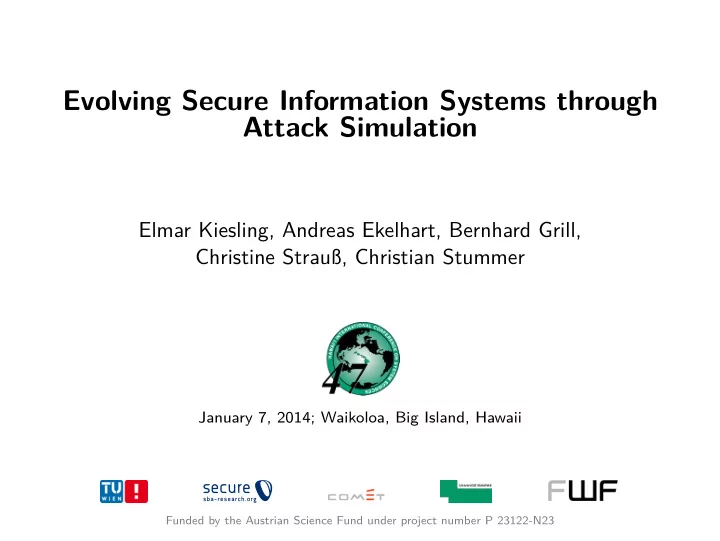

Evolving Secure Information Systems through Attack Simulation Elmar Kiesling, Andreas Ekelhart, Bernhard Grill, Christine Strauß, Christian Stummer January 7, 2014; Waikoloa, Big Island, Hawaii Funded by the Austrian Science Fund under project number P 23122-N23
Core ideas Security is. . . ◮ not the result of any particular technical measure ◮ a system property that emerges from interactions ◮ not an absolute concept, but involves tradeoffs ◮ meaningless without a specific threat model “Best” approach to secure a system is highly context-dependent : ◮ system characteristics ◮ threat landscape ◮ available resources ◮ decision-makers’ risk preferences 2 Evolving Secure Information Systems through Attack Simulation
Problem definition and approach Objective: choose an “optimal” set of security controls Solution approach: 1. Model a) abstract causal interdependencies b) the information system and its context c) adversaries and their behavior 2. Apply sets of security controls and simulate attacks 3. Optimize control sets w.r.t. multiple objectives 4. Support decision-maker in the selection of control 3 Evolving Secure Information Systems through Attack Simulation
Overview Attack Scenario Attacker Attacker model objectives Knowledge base Successful attacks Implementation cost Implementation time Detected attacks Successful attack actions Running cost Attack and Control Attack Pattern Abstract Attack Model Linking Attack Graph Simulation Engine System Model 1 1 1 0 0 0 0 1 0 0 1 1 Metaheuristic optimization 4 Evolving Secure Information Systems through Attack Simulation
Knowledge base Attack Scenario Attacker Attacker model objectives Knowledge base Successful attacks Implementation cost Implementation time Detected attacks Successful attack actions Running cost Attack and Control Attack Pattern Abstract Attack Model Linking Attack Graph Simulation Engine System Model 1 1 1 0 0 0 0 1 0 0 1 1 Metaheuristic optimization 5 Evolving Secure Information Systems through Attack Simulation
Knowledge base ◮ Captures abstract attack knowledge ◮ Actions linked through pre- and post-conditions 6 Evolving Secure Information Systems through Attack Simulation
Atomic attack actions Condition properties Pre-Conditions Post-Conditions
Attack patterns Knowledge base Attack and Control Attack Pattern Model Linking System Model 8 Evolving Secure Information Systems through Attack Simulation
Attack pattern linking 9 Evolving Secure Information Systems through Attack Simulation
Attack pattern linking + 9 Evolving Secure Information Systems through Attack Simulation
Attack pattern linking + 9 Evolving Secure Information Systems through Attack Simulation
Attack pattern linking 9 Evolving Secure Information Systems through Attack Simulation
Attack pattern linking 9 Evolving Secure Information Systems through Attack Simulation
CAPEC [?] ◮ Publicly available list of common attack patterns ◮ 413 patterns described in varying levels of detail ◮ Not fully formalized (textual descriptions) Transformation: 1. Generic CAPEC pattern → more specific actions e.g., “134 Email Injection” → emailKeylogger , emailBackdoor 2. Single CAPEC pattern → sequential atomic actions e.g., “49 Brute Forcing" → bruteForce , accessHost , accessData 3. Add additional actions e.g., accessData, accessHost 4. Formalize ◮ preconditions ◮ postconditions ◮ impact 10 Evolving Secure Information Systems through Attack Simulation
CAPEC example: Brute Force (1) Brute Force Attack Pattern ID: 112 ( Standard Attack Pattern Completeness: Typical Severity: High Status: Draft Complete ) Description Summary In this attack, some asset (information, functionality, identity, etc.) is protected by a finite secret value. The attacker attempts to gain access to this asset by using trial-and-error to exhaustively explore all the possible secret values in the hope of finding the secret (or a value that is functionally equivalent) that will unlock the asset. Examples of secrets can include, but are not limited to, passwords, encryption keys, database lookup keys, and initial values to one-way functions. The key factor in this attack is the attacker's ability to explore the possible secret space rapidly. This, in turn, is a function of the size of the secret space and the computational power the attacker is able to bring to bear on the problem. If the attacker has modest resources and the secret space is large, the challenge facing the attacker is intractable. While the defender cannot control the resources available to an attacker, they can control the size of the secret space. Creating a large secret space involves selecting one's secret from as large a field of equally likely alternative secrets as possible and ensuring that an attacker is unable to reduce the size of this field using available clues or cryptoanalysis. Doing this is more difficult than it sounds since elimination of patterns (which, in turn, would provide an attacker clues that would help them reduce the space of potential secrets) is difficult to do using deterministic machines, such as computers. Assuming a finite secret space, a brute force attack will eventually succeed. The defender must rely on making sure that the time and resources necessary to do so will exceed the value of the information. For example, a secret space that will likely take hundreds of years to explore is likely safe from raw-brute force attacks. Attack Execution Flow 11 Evolving Secure Information Systems through Attack Simulation
Recommend
More recommend